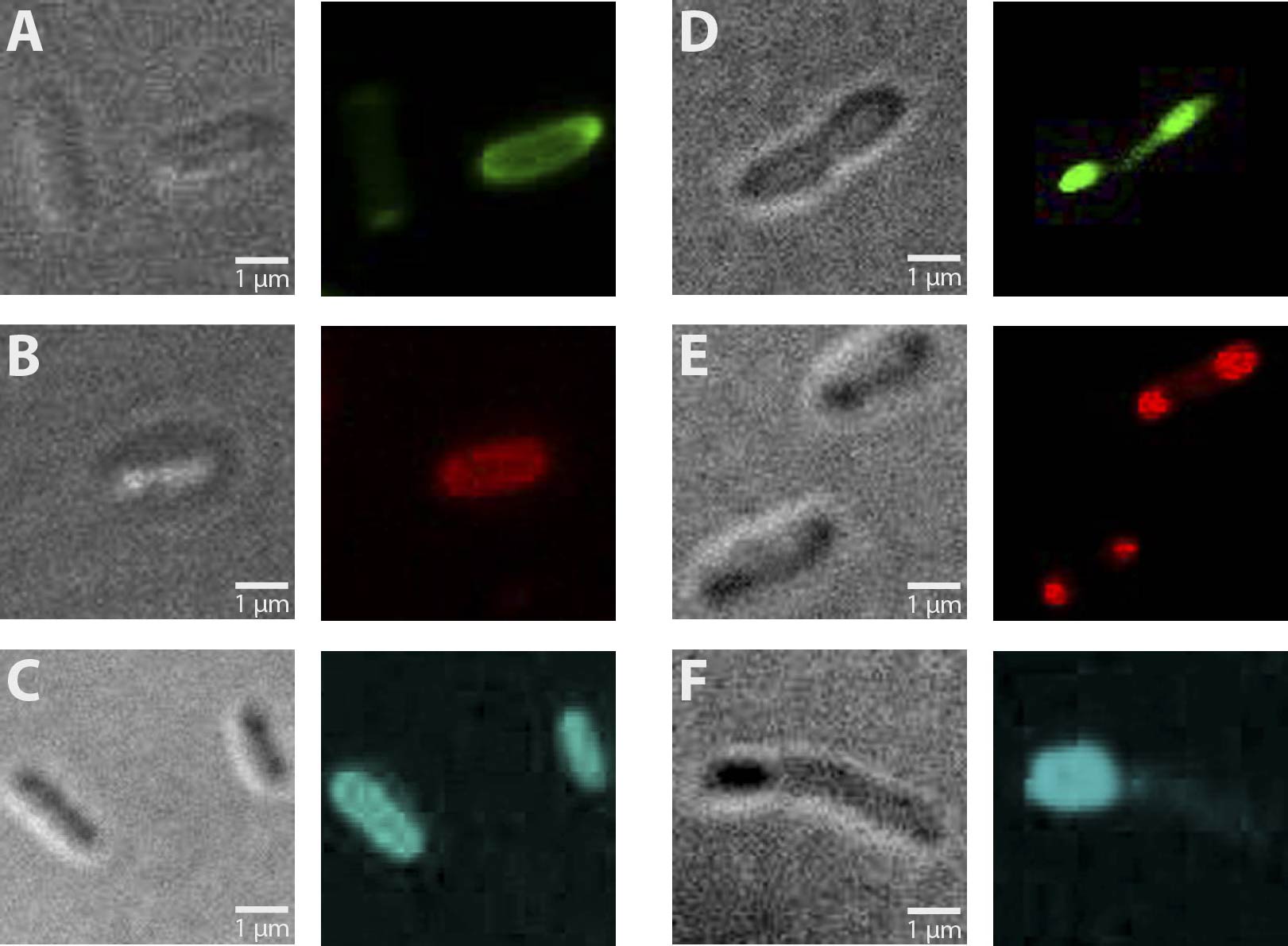Team:Marburg SYNMIKRO/Results
From 2012.igem.org

Contents |
Biobricks:
BBa_K866000 (CFP-Fusion Brick):
In order to evaluate putative recombination events in E. coli, we chose to generate fluorescent fusion proteins which are to be localized at different compartments within a cell. BBa_E0020 is a biobrick coding for the Cyan Fluorescent Protein (CFP). To build a CFP suitable for fusion proteins, we chose this biobrick as a template to create a CFP coding sequence (CDS) which can be cloned in-frame to other protein coding sequences via Standard Assembly.
The CFP-Fusion Brick was constructed by site directed mutagenesis through polymerase chain reaction (PCR) using primer MS_16 and MS_17. PCR products were separated by agarose gelelectrophoresis, gel extracted and cloned into pSB1C3 via Standard Assembly. Positive clones were verified by colony PCR and sequencing. This fusion brick was later on screened for expression and localization in E. coli as a synthesized fusion protein with A-modules GroES and AmiC using fluorescence microscopy.
BBa_K866001 (mRFP-Fusion Brick):
Besides a CFP-fusion protein, a monomeric Red Fluorescent Protein was contructed from BBa_E1010 as template. Site directed mutagenesis was performed via PCR using primer MS14 and MS15. PCR products were separated by agarose gelelectrophoresis, gel extracted and cloned into pSB1C3 via Standard Assembly. Positive clones have been verified by colony PCR and sequencing.
BBa_K866002 (G-segment Invertase):
The G-segment Invertase (Gin) from the phage Mu is a protein which can either cause inversions of gene segments flanked by gix sites as inverted repeats or cause deletions of gene segments flanked by gix-sites as direct repeats . Recombination event is facilitated by the Enhancer DNA-segment. We were aiming at constructing a biobrick that codes for Gin and contains a ribosomal binding site (RBS) attached upstream from it’s CDS.
Hence, we designed primer MS11 and MS12 which result in amplification of Gin containing the well characterized and strong RBS BBa_J61100 from the Anderson RBS-family. As template for PCR, chromosomal DNA from E. coli strain C600 Mucts62 (lysogenic for temperature sensitive phage Mu cts62) was used. PCR amplicons were separated via agarose gelelectrophoresis and cloned into pSB1C3 through Standard Assembly. Positive clones were evaluated by restriction digest and sequencing. The G-Segment Invertase Biobrick can be tested with different promotors in order to evaluate the optimal level of Gin-expression for recombination events in E. coli to occur.
BBa_K866003 (SacB Suicide Gene):
To select for recombination events in E. coli cells in a culture, the suicide gene SacB was chosen. In our final recombination construct, it shall be located between A and B-modules, causing a deletion of this suicide gene and thus select for positive recombination events. SacB codes for a levan sucrase, which can polymerize sucrose from growth media within Gram negative cells to levan, thus disturbing the cell’s metabolism and growth, leading to growth inhibition up to cell death. SacB was amplified using primer MS26 and MS27 from the suicide plasmid pNTPS via PCR. PCR products were separated by agarose gelelectrophoresis, gel extracted and cloned into pSB1C3 via Standard Assembly. Positive clones were verified by restriction digest and sequencing. BBa_K866003 can be fused to promoters of different strength and tested for optimal screening through cell death on sucrose rich media.
Experiments:
Generation of test constructs:
As a first step towards our complete recombination construct, we aimed at generating the putative recombination gene products i.e. the fusion of a complete A-module with a complete B-module with a gix-site in between. These putative recombination constructs would be the outcome if a recombination event would have occurred in the complete recombination construct. For this purpose, all three complete A-Modules, HU, GroES and AmiC have been synthesized. These A Modules consist each of one localization domain (AmiC, GroES or HU) with the RBS BBa_J61100 and the strong constitutive promotor BBa_J23108 located upstream. Downstream of localization domains, a gix site is located. Between promotor, RBS, localization domain and the gix site, the scar sequence from the standard assembly was included in order to test for the correct reading frame for expression. The complete A-modules are flanked by the standard prefix and suffix.
The complete A-modules coding for AmiC and GroES were cloned N-terminally to our fluorescent fusion protein sequences BBa_K866000 (CFP-Fusion Brick), BBa_K866001 (mRFP-Fusion brick as well as the biobrick BBa_K125500 (GFP-Fusion Brick) via standard assembly. Verification of fluorescence was performed via fluorescence microscopy.
Fluorescence microscopy:
In order screen for fluorescent E. coli harbouring our putative test constructs, positively selected colonies through antibiotic restistance have been subjected to fluorescence microscopy. For this purpose, colonies growing on LB-Agar supplemented with antibiotics for BBa_K866000 (CFP-Fusion Brick), BBa_K866001 (mRFP-Fusion brick) and BBa_K125500 (GFP-Fusion Brick), respectively, were cultured over-night in LB-medium with appropriate antibiotics. Small aliquots (10 µL) of overnight cultures were added onto 2% agarose-pads casted on microscope slides, covered by cover-slips and used for fluorescence microscopy.
Altogether, 6 different constructs have been observed for fluorescence, being AmiC-GFP, AmiC-CFP, AmiC-mRFP, GroES-GFP, GroES-CFP and GroES-mRFP. As visible in figure 1, fluorescence occurs in cells carrying each construct. Especially in cells expressing GroES-GFP and AmiC-GFP (fig. 1 E and B, respectively), intense fluorescence is detectable at cell poles for GroES and in the periplasm for AmiC in contrast to other cell compartments. Similar effects are also visible for GroES-mRFP and AmiC-mRFP, respectively (see fig. 1 D and A). For GroES-CFP and AmiC-CFP (fig. 1 F and C), fluorescence is detectable, yet for AmiC-CFP no precise localization can be determined.
As a result, our test constructs representing a putative recombination event of our planned recombination construct are expressed in E.coli. Furthermore, GFP- and mRFP fused A-modules show enhanced fluorescence at expected cell compartments, being cell poles for GroES and periplasm for AmiC.
Fig. 1: Fluorescent E. coli cells harbouring the fusion constructs of A- and B-modules. A: AmiC-mRFP. B: AmiC-GFP. C: AmiC-CFP. D: GroES-mRFP. E: GroES-GFP. F: GroES-CFP. G: E. coli harbouring a Promotor-RBS construct which serves as a non-fluorescent control. All images were taken via fluorescence microscopy at a magnification of x100.
 "
"

